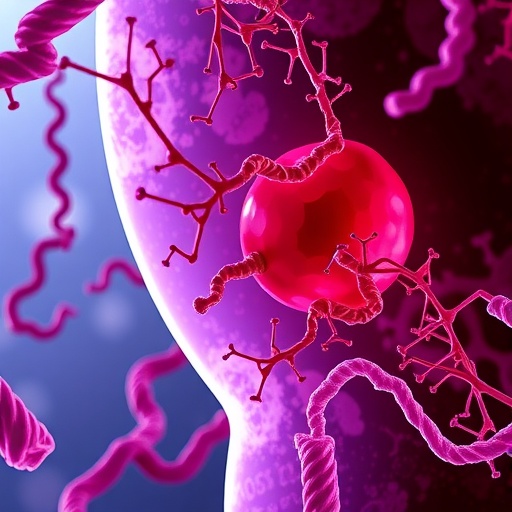Endometriosis is a complex, often misunderstood condition that affects millions of women worldwide. Despite its prevalence, much about the underlying mechanisms remains shrouded in uncertainty. A recent narrative review authored by Patel, Kalthur, Datta, and colleagues offers profound insights into the intricate relationship between iron, cellular senescence, and fibrosis within the context of endometriosis. This emerging interdisciplinary field underscores the need for a deeper understanding of how these factors interplay in the pathogenesis of this debilitating disease.
The role of iron in the body is multifaceted, serving as a critical component in various biochemical processes. However, in conditions such as endometriosis, iron can contribute to pathological changes that exacerbate inflammation and fibrosis. Elevated iron levels have been observed in ectopic endometrial tissues, raising questions about whether this excess is a consequence of bleeding, oxidative stress, or cellular senescence. Understanding how iron accumulates in these tissues can illuminate the processes that trigger the inflammatory response seen in endometriosis, suggesting potential therapeutic targets for managing the condition.
Cellular senescence, a state of irreversible cell division arrest, is another key player in the pathology of endometriosis. Senescent cells can accumulate in tissues, driven by various stressors including oxidative damage from elevated iron levels. The review highlights that senescent cells secrete a range of pro-inflammatory cytokines and growth factors, collectively referred to as the senescence-associated secretory phenotype (SASP). The SASP has been implicated in tissue remodeling processes, potentially fostering a fibrotic environment in endometriotic lesions. This relationship between senescence and fibrosis emphasizes the need for novel interventions targeting senescent cell clearance or modulation.
Fibrosis, characterized by excessive collagen deposition and scar tissue formation, is a prominent feature of advanced endometriosis. It can lead to significant pain and organ dysfunction, underscoring the clinical implications of this pathological process. The review notes that chronic inflammation, driven in part by senescent cells, contributes to the activation of fibroblasts, the primary cell type responsible for extracellular matrix production. Elevated iron levels may further exacerbate this process, indicating a potential vicious cycle where inflammation leads to fibrosis, thereby perpetuating pain and worsening disease outcomes.
Interestingly, the connection between iron, senescence, and fibrosis in endometriosis could also extend to potential biomarker development. Identifying changes in iron levels, cellular senescence markers, or specific cytokines within the SASP could provide insights into disease progression and response to therapy. Such biomarkers may not only aid in diagnosis but also help tailor individualized treatment plans based on the predominant underlying mechanisms in each patient.
In recent years, the scientific community has begun to recognize the importance of iron homeostasis in reproductive health. An imbalance, often seen in women with endometriosis, may trigger a cascade of events that culminates in the promotion of chronic inflammation and tissue repair mechanisms that fail to resolve properly. The narrative review posits that strategies aimed at restoring iron balance could be a promising avenue for research, potentially leading to novel therapeutic approaches for managing endometriosis.
Moreover, the interplay between iron and the immune system cannot be overlooked. Iron possesses immunomodulatory properties, and its dysregulation can influence immune cell function. In endometriosis, the presence of ectopic endometrial tissue may alter local immune responses, contributing to a microenvironment that favors inflammation and fibrosis. Targeting these immune pathways could yield significant therapeutic benefits, underscoring the necessity for an integrated approach to treatment that considers both iron metabolism and immune modulation.
As research continues to evolve, the need for interdisciplinary collaboration becomes increasingly apparent. By combining insights from molecular biology, immunology, and reproductive health, researchers can better elucidate the complexities of endometriosis. The commentary provided by Patel et al. serves as a clarion call for further studies that dissect these interconnections, fostering innovation in the management of this challenging condition.
The implications of the review extend beyond the laboratory, reflecting a potential paradigm shift in how clinicians approach endometriosis. Traditional management strategies often focus on symptom relief through hormonal therapies or surgical intervention. However, by embracing the multi-faceted nature of this disease, healthcare providers may be better equipped to develop strategies that target the root causes of endometriosis rather than merely alleviating symptoms.
Additionally, findings from this review could encourage patient-centered approaches that consider individual variations in disease presentation and progression. The recognition that iron homeostasis, senescence, and fibrosis are interlinked invites more personalized treatment regimens tailored to the unique pathophysiological context of each woman suffering from endometriosis.
In conclusion, the narrative review by Patel and colleagues highlights critical intersections between iron, senescence, and fibrosis in the pathology of endometriosis. This synthesis of knowledge not only advances our understanding of the disease but also paves the way for innovative therapeutic strategies that address its underlying drivers. As research progresses, there is hope that newfound insights will lead to improved outcomes for those affected by this common yet complex condition, ultimately transforming the landscape of endometriosis management.
The call to action is clear: robust, multidisciplinary research efforts are vital to unraveling the complexities of endometriosis. By fostering collaborations that span the realms of basic science, clinical research, and patient care, the scientific community can enhance the quality of life for countless women who face the challenges of this debilitating condition daily.
Subject of Research: The role of iron, cellular senescence, and fibrosis in endometriosis.
Article Title: The Nexus of Iron, Senescence, and Fibrosis in Endometriosis: A Narrative Review.
Article References:
Patel, R., Kalthur, G., Datta, R. et al. The Nexus of Iron, Senescence, and Fibrosis in Endometriosis: A Narrative Review. Reprod. Sci. (2025). https://doi.org/10.1007/s43032-025-01999-0
Image Credits: AI Generated
DOI:
Keywords: Endometriosis, Iron, Senescence, Fibrosis, Inflammation, Biomarkers, Chronic Pain, Therapeutic Strategies, Cytokines, Immune Modulation.




